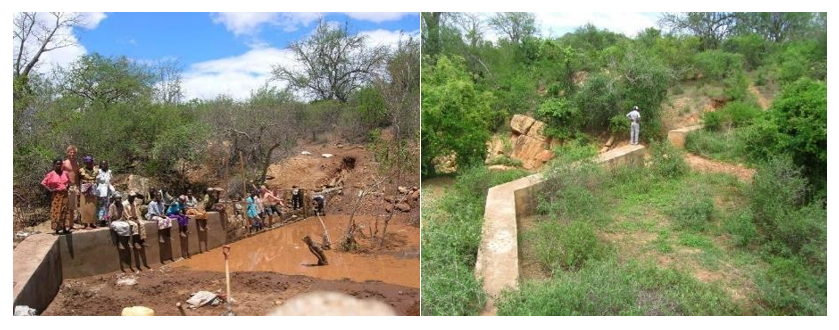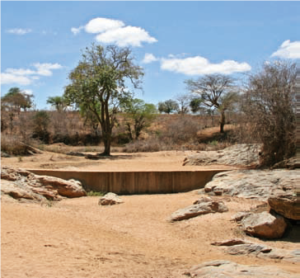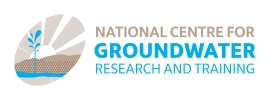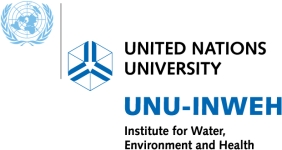A groundwater-based natural storage solution to make more water available for drinking and irrigation
Sand storage dams – What are they?
Sand storage dams, or simply sand dams, are small-scale structures built to retain water on seasonal rivers in semi-arid areas. They capture sand and water from the river flow and increase the thickness of the natural sand layer on the upstream side of the dam wall, thereby enlarging the storage capacity of the underlying alluvium aquifer. Often, the dam wall is constructed to partly obstruct groundwater flow through the riverbed, hence retaining the captured groundwater and limiting the “loss” downstream (Figure 1). Sand dams contribute to local water storage, largely from an artificial new aquifer, ensuring higher water quality and availability – usually with significant potential to last throughout the dry season. The loss to evaporation is also smaller with underground storage than from an open dam. Sand dams provide downstream benefits, as they reduce the peak river flow and may therefore prevent downstream floods. However, dry-season base flow may or may not be reduced, depending on the natural rate of release from the dams to downstream areas during the dry season. The highest concentration of sand dams with the strongest track record is found in Kenya, although there are examples throughout the world’s semi-arid regions, from Angola to Zimbabwe. Further examples are recorded in Japan, India, Thailand, the southwestern USA and Brazil [1].

Figure 1. A typical sand dam profile (source: RAIN Foundation [6]).
The town of Kitui in Kenya is situated 150 km east of Nairobi. The area is semi-arid, with rain falling in two wet seasons, usually as infrequent, intensive and highly erratic and unreliable storms. Climate change is exacerbating this pattern, causing floods to be even more severe and unpredictable. Most rivers are seasonal, only flowing during the wet seasons or after heavy events. During the dry season, surface water sources are scarce or absent. Walking distances to the few reliable water sources can be long. In response to these challenges, and given the good geomorphological and geological conditions for constructing sand storage dams, these have been taken up by many nongovernmental organizations (NGOs) and other development organizations in the area.
For example, in close collaboration with local communities, the Kenyan NGO Sahelian Solutions Foundation (SASOL) took the initiative to enhance water availability for rural communities in Kitui County. SASOL is well-known for applying 3R (Retention, Recharge and Reuse) technologies, and this is increasingly done through integrated approaches incorporating sand dams with off-take wells for multiple uses along with capacity building in dryland farming techniques and local resource management. This contributes to enhanced local water and food security as well as social capital and market integration.
In the decade that followed, more than 1,000 dams were built, providing communities with water for domestic use as well as small-scale irrigation and livestock production in Kitui, Machakos and Kajiado counties. Sand dams have also been constructed by other organizations, and even the county government of Kitui has set aside funds for the construction of 2,000 sand dams until 2021. Although the total number of sand dams is not known, about 1,800 are estimated to have been built in Kitui County alone. Furthermore, the technology is spreading, with at least another 50 sand dams in other African counties, including Burkina Faso, Ethiopia, Tanzania and Uganda.
The success of sand dam implementation depends critically on site selection. The subsurface and riparian zone should preferably consist of hard material to avoid erosion and shifting of the flow channel and to minimize water losses (Figure 1). In Kitui, many sand dams are built in cascades (i.e., several in sequence over a stretch of a stream), thus providing several hydrological benefits. First, this reduces the loss of water due to leakage, since a downstream dam will retain some of the water that underflows from upstream dams. Moreover, dams constructed in cascades raise groundwater levels, and thereby soil moisture, more extensively and over larger areas than do stand-alone dams.
Once an appropriate site is selected, the design is made based on the cross-sectional profile, peak river flow and required water yield. Then, the actual construction starts with the engineered block across the river (Figure 2). After this, it can take between 1 and 10 wet seasons for the sand storage dam to fill with sediment and water, depending on the characteristics of the upstream catchment. The catchment area upstream of the dam should be kept clean and in good sanitary condition – e.g., by removing the silt top-layer to prevent stagnant water, keeping sanitation facilities away from the stream, and removing animal droppings, dead animals, rocks and tree parts – to prevent infrastructure damage and water quality deterioration.

Figure 2. Sand dam in Kitui right after construction (right) and vegetation restoration of a sand dam after a few years in operation (photo: S. de Wildt).
Communities can take part in site selection and construction of sand storage dams through sand dam management groups, and by providing knowledge, labor and local materials. After construction, these groups ensure dam maintenance and management, and protect water quality, thus promoting local ownership. Early findings showed that close engagement with stakeholders and integrated approaches are crucial for successful outcomes [2].
Construction costs in Kitui are in the range of USD 9,000 for a well and a sand dam 30 m long, 3 m high in total and 1 m wide. This cost includes a 30-35% contribution from the community in the form of labor. Annual maintenance and monitoring costs are estimated at 10% of the investment costs.
A sand dam in Kitui provides 3,500-5,000 m3 of water storage during a rainy period. Assuming two rainy seasons per year, the total storage capacity is up to 10,000 m3/year [3]. On average, 210-350 people and 1,500 livestock units benefit from a single dam. Around 100,000 families are currently using water from sand dams in Kitui District.
Lessons learned and further challenges
The many sand dams constructed and operating in Kitui District help improve direct access to water and transform landscapes through raised groundwater levels [4]. The incomes of beneficiary families have increased substantially since construction of the sand dams. For households with dams, the distance to drinking water sources in the dry season has declined by 1,700 m, on average (in some cases, from over 10 km to less than 1 km) [2], and more water and soil moisture have become available for agriculture, increasing the irrigated crop area by 400% [2].
Typically, the increase in income surpasses the construction and maintenance costs of sand dams, making them profitable. However, it is critical to construct the sand dams cost-effectively and to maintain them properly to extend the lifetime of the investment (Figure 3). Prior definition of the technical solution, including design and construction planning, may limit community decision making, which might jeopardize commitment to maintenance [5]. Strong community involvement results in a more acceptable and sustainable solution.

Figure 3. Sand storage dam in good condition (photo: Acacia Water)
[1] Wikipedia. Sand Dam. https://en.wikipedia.org/wiki/Sand_dam.
[2] Pauw, W.P.; Mutiso, S.; Mutiso, G.; Manzi, H.K.; Lasage, R.; Aerts, J.C.J.H. 2008. An assessment of the social and economic effects of the Kitui sand dams: Community based adaptation to climate change. Nairobi, Kenya: SASOL Foundation; The Netherlands: Institute for Environmental Studies (IVM). http://www.adapts.nl/perch/resources/an-assessment-of-the-social-and-economic-effects-of-the-kitui-sand-dams.pdf
[3] Tuinhof, A.; van Steenbergen, F.; Vos, P.; Tolk, L. 2012; Profit from storage: The costs and benefits of water buffering. Wageningen, the Netherlands: 3R Water Secretariat.
[4] Tuinhof, A.; van den Ham, J.P.; Lasage, R. 2011. Economic valuation of water buffering, approach to cost benefit analysis of water buffering and illustrated by a case study from Kitui, Kenya. www.acaciawater.com.
[5] Ertsen, M.W.; Biesbrouck, B.; Postma, L.; van Westerop, M. n.d. Community organisation and participatory design of sand-storage dams in Kenya. The Netherlands: TU Delft. https://ocw.tudelft.nl/wp-content/uploads/Background-Paper.pdf
[6] RAIN Foundation. 2010. A practical guide to sand dam implementation. http://www.bebuffered.com/downloads/PracticalGuidetoSandDamImplementation_April_2011.pdf
Daniela Benedicto van Dalen1, Stefan de Wildt2 and Bernard Muendo3
1 Acacia Water, Gouda, the Netherlands; Email: daniela.benedicto@acaciawater.com
2 Acacia Water, Gouda, the Netherlands
3 Sahelian Solutions Foundation (SASOL), Kitui, Kenya





































